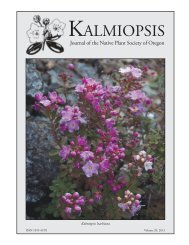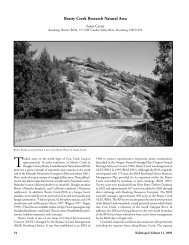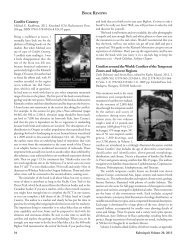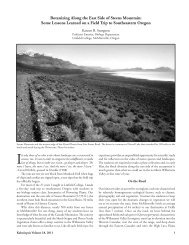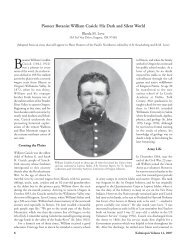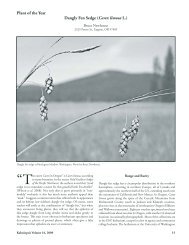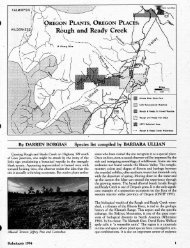You also want an ePaper? Increase the reach of your titles
YUMPU automatically turns print PDFs into web optimized ePapers that Google loves.
shrubs and ferns includes salal, Cascade <strong>Oregon</strong>grape, creeping snowberry, and western swordfern(Polystichum munitum). Old growth Douglas fir,probably to 300 years old, reaches 150 feet tall and 5feet in diameter. Wind-thrown trees that extend intothe southern edges of some meadows are thoughtto date from the 1962 Columbus Day Storm.Where wind-thrown trees were accessible, they weresalvaged by logging soon after the storms. Areasclearcut within the RNA prior to its establishment,about 100 acres, are now densely stocked with trees8 inches in diameter, 28 to 38 years old. The oldgrowth preserved by the RNA is isolated from otherold growth stands because the private landsurrounding the RNA was clearcut relativelyrecently. Over the past century, most of the forestland has been harvested in the Coburg Hills, wherethe pattern of ownership forms a checkerboard ofprivate, federal, and state ownership.Rare SpeciesFour species located at the RNA are consideredlocally or regionally rare. Eyelash flower and common blue cupgrow as widely scattered individuals in the meadows and rockyareas. These species are on the Lane County list C, meaning thatthey are of interest in Lane County for tracking or review purposes.(Although the RNA is in Linn County, it borders Lane County;hence the Lane County list was used to assess locally rare species).These two species are more common in eastern <strong>Oregon</strong>. The LaneCounty List of Rare and Endangered Vascular Plants, prepared bythe Emerald Chapter of the Native Plant Society, indicates thatthese species are of limited occurrence in the county, and could bethreatened by off road vehicle use. Eyelash flower is a small annual(to 16 inches) in the Asteraceae, with white flowers to ¾ inchIn the foreground, bristly manzanita (Arctostaphylos columbiana) softens the ecotonebetween forest and grassland; in the background, a view to the east of the Coburg Hills.Photo by Cheshire Mayrsohn.across. The annual Campanulaceae, common blue cup, also growsto 16 inches tall, and has deep blue funnel shaped flowers that areabout ½ inch long.Vernally wet seeps or small pools within the balds supportKellogg’s rush, a BLM Tracking species, <strong>Oregon</strong> Natural HeritageProgram list 3. It is a small annual species, only 2 inches tall. It hasthin stems topped by a small inflorescence, and basal, acicular leaves.Discovered in 1992, the few populations scattered across the RNAare small, most comprising fewer than 50 individuals each.The crustose lichen Lecidea dolodes that grows on the trunks ofopen grown Douglas fir is currently a BLM Tracking species, andon the <strong>Oregon</strong> Natural Heritage Program list 3.Geology and SoilsMeadows, rock outcrops, and forests form a mosaic in <strong>Horse</strong> <strong>Rock</strong> <strong>Ridge</strong> RNA. Photo byCheshire Mayrsohn.The Coburg Hills are a western extension of theCascade foothills that rise from the east side of theWillamette Valley, bounded by the Calapooia RiverValley on the north, and the Mohawk River Valleyon the southeast. A main ridge divides the RNAso that about two thirds of the area, including thebalds, faces southwest, while the rest facesnorthwest. Much of the RNA is steep and rocky,with elevations ranging from 1550 to 2864 feet.The rocks consist of basalt and basaltic andesitedating from the Oligocene and early Miocene,about 24 million years ago. Vesicles formed by gasestrapped in the lava were later filled by quartz andzeolite precipitated from water. Basalt with thisfeature is known as amygdaloidal. The amygdalescan be found eroded from rock in the RNA. Theprominent elongate rock outcrops in the RNA arethe result of dikes of fine-grained basalt that formedin cracks in the amygdaloidal basalt. These dikes aremore resistant to erosion than the surrounding rocks.Kalmiopsis Volume 11, 2004 65
Few wildlife surveys haveoccurred in the area, but aresident black bear, sometimeswith cubs, has been sighted over a series of years. Sandhillcranes can be very numerous overhead during their migrations;they migrate along the foothills rather than over the centralWillamette Valley. A spotted owl occurs within a mile of the RNA,which is within foraging range of the owl. Golden eagles have beenreported near the RNA. It is likely that many other wildlife speciesuse or travel through this area.Human HistoryErosion-resistant basalt dikes provide habitat for a variety of lichens,bryophytes, ferns, and native grasses. Photo by Cheshire Mayrsohn.Native Americans of the Kalapuya tribes are thought to havefrequented this site for vision quests, as high ridges with a viewwere generally preferred for these activities.The meadow area is thought to have been heavily grazed bysheep early in the 20 th century, but no grazing has occurred sinceat least the early 1960s. Evidence of grazing includes the abundanceof introduced grasses, such as hedgehog dogtailgrass (Cynosurusechinatus), European silver hairgrass (Aira caryophyllea), soft brome(Bromus hordeaceus), ripgut brome (B. rigidus), and medusaheadwildrye (Taeniatherum caput-medusae). Thirty-four introducedspecies have invaded the RNA, including the state-listed noxiousweeds bull thistle (Cirsium vulgare), tansy ragwort (Senecio jacobaea),and St. John’s wort (Hypericum perforatum). Much of the areapreviously occupied by a blue wildrye community is now dominatedby introduced annual grasses. There have been no attempts tocontrol non-native species in the RNA.As mentioned previously, evidence of harvest activities are visiblein portions of the RNA that were clearcut and replanted between1960 and 1982. A trail created by hikers along the ridge receivesoccasional use. The RNA has been the destination for botany fieldIn the open areas, soilsconsist of rock outcrop andentisols, which are relativelyyoung, poorly developedsoils (i.e., lack well-defineddiagnostic horizons). Theseentisols are shallow, generally7 to 14 inches deep (up to 3feet in partially forestedareas), and contain a highproportion of gravel andcobble. In the forested area,most of the soils are in theKinney Series (Curtis 2003).These soils derive fromtuffaceous colluvium andconsist of a 15-inch surfacelayer of cobbly loam over asubsoil of about 20 inches ofcobbly clay loam. Depth tobedrock averages 4.5 feet.WildlifeA hiking trail follows the prominent ridge that runs northwest-southeast across the RNA. Photo by Cheshire Mayrsohn.66 Kalmiopsis Volume 11, 2004
trips by individuals and classes since the 1970s. A radio towercomplex sits atop <strong>Horse</strong> <strong>Rock</strong>, in a young forest plantation, onland leased to the Bonneville Power Administration in thenorthwest corner of the RNA. In 2000, the BLM establishedpermanent transects across the meadow/forest ecotone to monitorvegetation changes. Air quality is also being monitored bychemical analysis of lichens in the area.AcknowledgmentsAdditional information was provided by Nancy Wogen andCheshire Mayrsohn, botanists with the Eugene District BLM. Thevascular plant list was compiled by Cheshire Mayrsohn, NancyWogen, Alan B. Curtis, John Christy, Peter Zika, Reid Schuller,and Bruce Newhouse. Dr. Bruce McCune compiled the lichenlists. John Christy and Bruce Newhouse compiled the bryophytelists. All photographs are by Cheshire Mayrsohn.ReferencesCurtis AB. 2003. <strong>Horse</strong> <strong>Rock</strong> <strong>Ridge</strong> Research Natural Area: GuidebookSupplement 27. Portland (OR): USDA Forest ServiceGen Tech Rep PNW-GTR-571. 30 p.Vander Schaaf D. 1993. <strong>Horse</strong> <strong>Rock</strong> <strong>Ridge</strong> RNA/ACEC ManagementPlan (Draft). Unpublished document on file at BLMEugene District office.Vascular Plant Species ListNomenclature for the vascular plants follows the <strong>Oregon</strong> FloraProject checklist. Names of taxa native to <strong>Oregon</strong> are printed initalic Garamond; alien taxa are in italic Gill Sans, a sans-serif type.Lists for nonvascular plants, fungi and lichens are available on theNPSO website, http://www.npsoregon.org/lists/plantlists/horse_rock_ridge.htmFERNS AND THEIR ALLIESDENNSTAEDTIACEAE (Bracken Family)Pteridium aquilinum (L.) Kuhn var. pubescens Underw. (westernbrackenfern)DRYOPTERIDACEAE (Wood Fern Family)Athyrium filix-femina (L.) Mert. (lady fern)Cystopteris fragilis (L.) Bernh. (brittle fern)Polystichum munitum (Kaulfuss) K. Presl (western swordfern)ISOETACEAE (Quillwort Family)Isoetes nuttallii A. Br. (Nuttall’s quillwort)POLYPODIACEAE (Polypody Family)Polypodium glycyrrhiza D.C. Eaton (licorice fern)PTERIDACEAE (Brake Family)Adiantum aleuticum (Rupr.) C.A. Paris (Aleutian maidenhair)Aspidotis densa (Brack.) Lellinger (podfern)Cheilanthes gracillima D.C. Eaton (lace lipfern)Cryptogramma acrostichoides R. Br. (American parsley fern)Pentagramma triangularis (Kaulf.) Yatsk., Windham, E. Wollenw.(gold back fern)SELAGINELLACEAE (Spike-moss Family)Selaginella wallacei Hieron. (Wallace’s spikemoss)GYMNOSPERMSCUPRESSACEAE (Cypress Family)Calocedrus decurrens (Torr.) Florin (incense cedar)Thuja plicata D. Don (western red cedar)PINACEAE (Pine Family)Pseudotsuga menziesii (Mirbel) Franco var. menziesii (Douglas fir)Tsuga heterophylla (Raf.) Sarg. (western hemlock)TAXACEAE (Yew Family)Taxus brevifolia Nutt. (Pacific yew)DICOTYLEDONSACERACEAE (Maple Family)Acer macrophyllum Pursh (bigleaf maple)Acer circinatum Pursh (vine maple)Acer glabrum Torr. var. douglasii (Hook.) Dippel (Douglas maple)ANACARDIACEAE (Family)Toxicodendron diversilobum (Torr. & A. Gray) Greene (poison oak)APIACEAE (Carrot Family)Daucus pusillus Michx. (American wild carrot)Lomatium utriculatum (Nutt.) J.M. Coult. & Rose (spring gold)Osmorhiza berteroi DC. (mountain sweet cicely)Perideridia montana (Blank.) Dorn (Gairdner’s yampah)Sanicula bipinnatifida Douglas ex Hook. (purple snakeroot)Sanicula crassicaulis Poepp. (Pacific snakeroot)APOCYNACEAE (Dogbane Family)Apocynum androsaemifolium L. (spreading dogbane)ASTERACEAE (Sunflower Family)Achillea millefolium L. (common yarrow)Adenocaulon bicolor Hook. (pathfinder)Anisocarpus madioides Nutt. (woodland tarweed)Balsamorhiza deltoidea Nutt. (deltoid balsamroot)Blepharipappus scaber Hook. (eyelash flower)Cirsium vulgare (Savi) Ten. (bull thistle)Erigeron compositus Pursh var. glabratus Macoun (dwarf mountainfleabane)Eriophyllum lanatum (Pursh) J. Forbes (<strong>Oregon</strong> sunshine)Gnaphalium palustre Nutt. (lowland cudweed)Hemizonella minima (A. Gray) A. Gray (least tarweed)Hieracium albiflorum Hook. (white flowered hawkweed)Hypochaeris glabra L. (smooth cat’s ear)Hypochaeris radicata L. (rough cat’s ear)Lactuca muralis (L.) Fresen. (wall lettuce)Leontodon hirtus L. (rough hawkbit)Leucanthemum vulgare Lam. (oxeye daisy)Madia exigua (Sm.) A. Gray (little tarweed)Madia gracilis (Sm.) D.D. Keck (slender tarweed)Senecio integerrimus Nutt. var. exaltatus (Nutt.) Cronquist (tallwestern groundsel)Senecio jacobaea L. (tansy ragwort)Sonchus asper (L.) Hill (prickly sowthistle)Taraxacum officinale Weber ex F.H. Wigg. (common dandelion)BERBERIDACEAE (<strong>Oregon</strong>-grape Family)Achlys triphylla (Sm.) DC. (vanillaleaf)Berberis aquifolium Pursh (tall <strong>Oregon</strong> grape)Berberis nervosa Pursh (Cascade <strong>Oregon</strong> grape)BETULACEAE (Birch Family)Alnus rubra Bong. (red alder)Kalmiopsis Volume 11, 2004 67
Corylus cornuta Marshall var. californica (A. DC.) W.M. Sharp(California hazelnut)BORAGINACEAE (Borage Family)Cryptantha intermedia (A. Gray) Greene (common cryptantha)Myosotis discolor Pers. (yellow and blue scorpion grass)Plagiobothrys scouleri (Hook. & Arn.) I.M. Johnst. var. scouleri(Scouler’s popcorn flower)BRASSICACEAE (Mustard Family)Arabis glabra (L.) Bernh. (tower mustard)Athysanus pusillus (Hook.) Greene (sandweed)Barbarea orthoceras Ledeb. (American wintercress)Brassica rapa L. (field mustard)Cardamine oligosperma Nutt. (little western bittercress)Cardamine pulcherrima Greene var. tenella (Pursh) C.L. Hitchc.(slender toothwort)Draba verna L. (spring whitlowgrass)Thysanocarpus curvipes Hook. (sand fringepod)CALLITRICHACEAE (Water-starwort Family)Callitriche heterophylla Pursh var. bolanderi (Hegelm.) Fassett(Bolander’s water starwort)Callitriche verna L. (spring starwort)CAMPANULACEAE (Bellflower Family)Campanula scouleri Hook. ex A. DC. (Scouler’s harebell)Githopsis specularioides Nutt. (common blue cup)Heterocodon rariflorum Nutt. (heterocodon)CAPRIFOLIACEAE (Honeysuckle Family)Linnaea borealis L. var. longiflora Torr. (western twinflower)Lonicera ciliosa (Pursh) Poir. ex DC. (orange honeysuckle)Lonicera hispidula (Lindl.) Douglas ex Torr. & A. Gray (hairyhoneysuckle)Symphoricarpos albus (L.) S.F. Blake (common snowberry)Symphoricarpos mollis Nutt. (creeping snowberry)Viburnum edule (Michx.) Raf. (highbush cranberry)CARYOPHYLLACEAE (Pink Family)Arenaria serpyllifolia L. (thyme leaf sandwort)Cerastium nutans Raf. (nodding chickweed)Cerastium glomeratum Thuill. (sticky chickweed)Minuartia tenella (Nutt.) Mattf. (slender sandwort)Moehringia macrophylla (Hook.) Fenzl (bigleaf sandwort)Silene gallica L. (windmill pink)Stellaria nitens Nutt. (shining chickweed)CELASTRACEAE (Staff-tree Family)Paxistima myrsinites (Pursh) Raf. (<strong>Oregon</strong> boxwood)CORNACEAE (Dogwood Family)Cornus nuttallii Audubon ex Torr. & A. Gray (Pacific dogwood)CUCURBITACEAE (Gourd Family)Marah oreganus (Torr. & A. Gray) Howell (old man in the ground)CRASSULACEAE (Stonecrop Family)Sedum lanceolatum Torr. (lanceleaf stonecrop)Sedum oreganum Nutt. (<strong>Oregon</strong> stonecrop)Sedum spathulifolium Hook. (Pacific stonecrop)ERICACEAE (Heath Family)Arbutus menziesii Pursh (Pacific madrone)Arctostaphylos columbiana Piper (bristly manzanita)Chimaphila menziesii (R. Br.) Spreng. (little prince’s pine)Chimaphila umbellata (L.) W. Bartram (prince’s pine)Gaultheria shallon Pursh (salal)Vaccinium parvifolium Sm. (red huckleberry)EUPHORBIACEAE (Spurge Family)Euphorbia peplus L. (petty spurge)FABACEAE (Legume Family)Lathyrus polyphyllus Nutt. (leafy peavine)Lotus micranthus Benth. (field lotus)Lupinus bicolor Lindl. (miniature lupine)Lupinus lepidus Douglas ex Lindl. (dwarf lupine)Rupertia physodes (Hook.) J.W. Grimes (scurf pea)Trifolium microcephalum Pursh (woolly clover)Trifolium microdon Hook. & Arn. (thimble clover)Trifolium repens L. (white clover)Trifolium subterraneum L. (subterranean clover)Trifolium variegatum Nutt. (whitetip clover)Trifolium willdenovii Spreng. (tomcat clover)Trifolium wormskjoldii Lehm. (springbank clover)Vicia americana Muhl. ex Willd. (American vetch)Vicia nigracans Hook.& Arn. var. gigantea (Hook.) S.L. Broich(giant vetch)FAGACEAE (Oak Family)Chrysolepis chrysophylla (Douglas ex Hook.) Hjelmq. (chinquapin)Quercus garryana Douglas ex Hook. (<strong>Oregon</strong> white oak)FUMARIACEAE (Fumitory Family)Dicentra formosa (Andrews) Walp. (bleeding heart)GENTIANACEAE (Gentian Family)Centaurium muhlenbergii (Griseb.) W. Wight ex Piper (Montereycentaury)GERANIACEAE (Geranium Family)Erodium cicutarium (L.) L’Hér. ex Aiton (redstem filaree)Geranium dissectum L. (cutleaf geranium)Geranium molle L. (dovefoot geranium)GROSSULARIACEAE (Gooseberry Family)Ribes sanguineum Pursh (red flowering currant)HYDRANGEACEAE (Hydrangea Family)Philadelphus lewisii Pursh (syringa)Whipplea modesta Torr. (yerba de selva)HYDROPHYLLACEAE (Waterleaf Family)Nemophila parviflora Douglas ex Benth. (small flowered nemophila)Phacelia linearis (Pursh) Holz. (threadleaf phacelia)Phacelia nemoralis Greene (woodland phacelia)Phacelia sericea (Graham) A. Gray var. ciliosa (Rydb.) J.M. Gillett(blue alpine phacelia)HYPERICACEAE (St. John’s Wort Family)Hypericum perforatum L. (Klamathweed)LAMIACEAE (Mint Family)Prunella vulgaris L. (self heal)Satureja douglasii (Benth.) Briq. (yerba buena)Stachys cooleyae A. Heller (great betony)Trichostema lanceolatum Benth. (vinegar weed)LINACEAE (Flax Family)Linum usitatissimum L. (linseed)MALVACEAE (Mallow Family)Sidalcea virgata Howell (rose checkermallow)ONAGRACEAE (Evening Primrose Family)Circaea alpina L. (enchanter’s nightshade)Clarkia amoena (Lehm.) A. Nelson & J.F. Macbr. (farewell to spring)Clarkia gracilis (Piper) A. Nelson & J.F. Macbr. (slender godetia)Clarkia purpurea (Curtis) A. Nelson & J.F. Macbr. (winecup fairyfan)Epilobium brachycarpum C. Presl (tall annual willowherb)68 Kalmiopsis Volume 11, 2004
Epilobium minutum Lindl. (small flowered willowherb)OROBANCHACEAE (Broom-rape Family)Orobanche fasciculata Nutt. (clustered broomrape)Orobanche uniflora L. var. minuta (Suksd.) Beck (nakedbroomrape)Orobanche uniflora L. var. purpurea (A. Heller) Achey (purplebroomrape)OXALIDACEAE (Oxalis Family)Oxalis oregana Nutt. ex Torr. & A. Gray (<strong>Oregon</strong> wood sorrel)PLANTAGINACEAE (Plantain Family)Plantago lanceolata L. (English plantain)POLEMONIACEAE (Phlox Family)Collomia heterophylla Hook. (varied leaf collomia)Gilia capitata Sims (bluefield gilia)Linanthus bicolor (Nutt.) Greene (bicolored linanthus)Phlox adsurgens Torr. (woodland phlox)Phlox gracilis (Hook.) Greene (slender phlox)POLYGONACEAE (Buckwheat Family)Eriogonum nudum Douglas ex Benth. (barestem buckwheat)Rumex acetosella L. (sheep sorrel)Rumex crispus L. (curly dock)PORTULACACEAE (Purslane Family)Claytonia exigua Torr. & A. Gray ssp. exigua (pale springbeauty)Claytonia perfoliata Donn ex Willd. (miner’s lettuce)Claytonia sibirica L. (candyflower)Montia parvifolia (Moç. ex DC.) Greene (littleleaf miner’slettuce)PRIMULACEAE (Primrose Family)Dodecatheon hendersonii A. Gray (Henderson’s shooting star)Dodecatheon pulchellum (Raf.) Merr. var. pulchellum (yellowthroatshooting star)Trientalis latifolia Hook. (western starflower)RANUNCULACEAE (Buttercup Family)Anemone deltoidea Hook. (threeleaf anemone)Aquilegia formosa Fisch. ex DC. (red columbine)Delphinium menziesii DC. (Menzies’ larkspur)Ranunculus occidentalis Nutt. var. occidentalis (western buttercup)Thalictrum occidentale A. Gray (western meadowrue)ROSACEAE (Rose Family)Prunus emarginata (Douglas ex Hook.) Walp. (bitter cherry)Amelanchier alnifolia (Nutt.) Nutt. ex M. Roem. (serviceberry)Crataegus monogyna Jacq. (English hawthorn)Fragaria vesca L. var. crinita (Rydb.) C.L. Hitchc. (hairy woodlandstrawberry)Fragaria virginiana Duchesne var. platypetala (Rydb.) H.M. Hall(broad petal strawberry)Holodiscus discolor (Pursh) Maxim. (creambush oceanspray)Physocarpus capitatus (Pursh) Kuntze (Pacific ninebark)Potentilla glandulosa Lindl. var. glandulosa (sticky cinquefoil)Rosa gymnocarpa Nutt. (little wild rose)Rubus leucodermis Douglas ex Torr. & A. Gray (western blackraspberry)Rubus parviflorus Nutt. (thimbleberry)Rubus ursinus Cham. & Schltdl. (Pacific dewberry)RHAMNACEAE (Buckthorn Family)Rhamnus purshiana DC. (cascara)Ceanothus sanguineus Pursh (redstem ceanothus)Ceanothus velutinus Douglas ex Hook. (tobacco brush)RUBIACEAE (Madder Family)Galium oreganum Britton (<strong>Oregon</strong> bedstraw)Galium aparine L. (cleavers)Galium triflorum Michx. (sweetscented bedstraw)Kelloggia galioides Torr. (kelloggia)Sherardia arvensis L. (blue fieldmadder)SALICACEAE (Willow Family)Salix geyeriana Andersson (Geyer’s willow)Salix scouleriana Barratt ex Hook. (Scouler’s willow)Salix sitchensis Sanson ex Bong. (Sitka willow)SAXIFRAGACEAE (Saxifrage Family)Heuchera micrantha Douglas ex Lindl.var. micrantha (crevicealumroot)Lithophragma parviflorum (Hook.) Nutt. ex Torr. & A. Gray (smallfloweredfringecup)Saxifraga cespitosa L. (tufted alpine saxifrage)Saxifraga integrifolia Hook. (common western saxifrage)Saxifraga nuttallii Small (Nuttall’s saxifrage)Saxifraga occidentalis S. Watson (western mountain saxifrage)SCROPHULARIACEAE (Figwort Family)Castilleja attenuata (A. Gray) T.I. Chuang & Heckard (narrowleafpaintbrush)Castilleja hispida Benth. var. hispida (harsh paintbrush)Castilleja tenuis (A. Heller) T.I. Chuang & Heckard (hairy owl clover)Collinsia grandiflora Douglas ex Lindl. (large flowered blue eyed Mary)Collinsia parviflora Douglas ex Lindl. (small flowered blue eyed Mary)Digitalis purpurea L. (foxglove)Gratiola ebracteata Benth. ex A. DC. (bractless hedge hyssop)Mimulus alsinoides Douglas ex Benth. (chickweed monkeyflower)Mimulus guttatus DC. (common monkeyflower)Nothochelone nemorosa (Douglas ex Lindl.) Straw (woodlandbeardtongue)Synthyris reniformis (Douglas ex Benth.) Benth. (snow queen)Triphysaria pusilla (Benth.) T.I. Chuang & Heckard (dwarf owl clover)Veronica arvensis L. (common speedwell)VALERIANACEAE (Valerian Family)Plectritis congesta (Lindl.) DC. (sea blush)Valeriana sitchensis Bong. (mountain heliotrope)VIOLACEAE (Violet Family)Viola sempervirens Greene (evergreen violet)MONOCOTYLEDONSCYPERACEAE (Sedge Family)Carex rossii W. Boott (Ross sedge)IRIDACEAE (Iris Family)Iris chrysophylla Howell (slender tubed iris)Iris tenax Douglas ex Lindl. (<strong>Oregon</strong> iris)JUNCACEAE (Rush Family)Juncus bufonius L. (toad rush)Juncus kelloggii Engelm. (Kellogg’s rush)Luzula comosa E. Mey. (Pacific woodrush)LILIACEAE (Lily Family)Allium acuminatum Hook. (tapertip onion)Allium amplectens Torr. (slim leaf onion)Allium crenulatum Wiegand (scalloped onion)Brodiaea coronaria (Salisb.) Engl. (crown brodiaea)Calochortus tolmiei Hook. & Arn. (Tolmie’s mariposa)Camassia leichtlinii (Baker) S. Watson (large camas)Kalmiopsis Volume 11, 2004 69
Dichelostemma congestum (Sm.) Kunth (ookow)Erythronium oreganum Applegate (<strong>Oregon</strong> fawnlily)Fritillaria affinis (Schult.) Sealy (checker lily)Maianthemum stellatum (L.) Link (starry false Solomon’s seal)Prosartes smithii (Hook.) Utech, Shinwari & Kawano(largeflower fairybells)Trillium ovatum Pursh (western wakerobin)Triteleia hyacinthina (Lindl.) Greene (hyacinth brodiaea)Zigadenus venenosus S. Watson var. venenosus (meadow deathcamas)POACEAE (Grass Family)Achnatherum lemmoni (Vasey) Barkworth (Lemmon’s needlegrass)Agrostis capillaris L. (colonial bentgrass)Agrostis exarata Trin. (spike bentgrass)Aira caryophyllea L. (European silver hairgrass)Aira praecox L. (little hairgrass)Bromus hordeaceus L. ssp. hordeaceus (soft brome)Bromus orcuttianus Vasey (Orcutt’s brome)Bromus pacificus Shear (Pacific brome)Bromus rigidus Roth (ripgut brome)Cynosurus echinatus L. (hedgehog dogtailgrass)Danthonia californica Bol. (California oatgrass)Elymus glaucus Buckley (blue wildrye)Festuca occidentalis Hook. (western fescue)Festuca roemeri Yu.E. Alexeev (<strong>Oregon</strong> fescue)Festuca subulata Trin. (nodding fescue)Holcus lanatus L. (common velvetgrass)Hordeum marinum Huds. ssp. gussonianum (Parl.) Thell.(Mediterranean barley)Koeleria macrantha (Ledeb.) Schult. (junegrass)Melica subulata (Griseb.) Scribn. (Alaska oniongrass)Poa pratensis L. (Kentucky bluegrass)Poa secunda J. Presl (Sandberg bluegrass)Trisetum canescens Buckley (tall trisetum)Vulpia microstachys (Nutt.) Munro ex Benth. (small fescue)Vulpia myuros (L.) C.C. Gmel. (foxtail fescue)ORCHIDACEAE (Orchid Family)Calypso bulbosa (L.) Oakes (fairyslipper orchid)Corallorhiza maculata (Raf.) Raf. (spotted coralroot)Goodyera oblongifolia Raf. (rattlesnake plantain)Piperia elegans (Lindl.) Rydb. (elegant rein orchid)Spiranthes romanzoffiana Cham. (hooded ladies tresses)Douglas Goldenberg is a botanist currently working with theEugene District BLM. He has worked since 1989 as a botanist,with work in <strong>Oregon</strong>, California, Washington and Brazil. Hecompleted biology and botany degrees at Humboldt <strong>State</strong><strong>University</strong> (BS) and <strong>Oregon</strong> <strong>State</strong> <strong>University</strong> (MS).NPSO OCCASIONAL PAPERSAtlas of <strong>Oregon</strong> CarexRich with information, adistillation of many decadesof herbarium recordsand sightings by <strong>Oregon</strong>botanists. Contains 128location maps, one for eachCarex taxon in <strong>Oregon</strong>.Also included are a synonymy,fun facts aboutsedges, a history of theproject, and <strong>Oregon</strong> geographymaps. 29 pages.Authors: Barbara L. Wilson, Richard Brainerd, ManuelaHuso, Keli Kuykendall, Danna Lytjen, Bruce Newhouse,Nick Otting, Scott Sundberg, and Peter Zika.Publication Date: May 1999. Price: $5.Louis F. Henderson (1853-1942)The Grand Old Man of Northwest BotanyBotanist Louis Henderson was a larger-than-life figure inthe mold of John Muir. Possessed of great physical strengthand stamina, he energetically explored the mountains,deserts, forests, and seacoastsof the Northwest for65 years, adding greatly toour knowledge of the flora.This fascinating, peerreviewed,64-page biographyincludes 56 historicand modern images. It iscarefully and exhaustivelyresearched with 133 notesplus chronology, lists ofpublications, and plantsnamed for Henderson.Author: Rhoda M. Love, PhD.Publication Date: Fourth printing February 2004.Price: $10.To order either or both Occasional Papers, send check forthe appropriate amount (made payable to NPSO) to:Occasional Papers, Native Plant Society of <strong>Oregon</strong>, POBox 902, Eugene, <strong>Oregon</strong> 97440-0902.70 Kalmiopsis Volume 11, 2004



